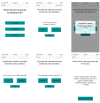An mHealth App for Decision-Making Support in Wound Dressing Selection (WounDS): Protocol for a User-Centered Feasibility Study
- PMID: 29691213
- PMCID: PMC5941095
- DOI: 10.2196/resprot.9116
An mHealth App for Decision-Making Support in Wound Dressing Selection (WounDS): Protocol for a User-Centered Feasibility Study
Abstract
Background: Primary care health professionals, especially family physicians, see a variety of wounds, and yet-despite the frequency of providing wound care-many family physicians do not feel confident in wound care management. This is partly due to a lack of formal wound education in Family Medicine programs. While there are numerous electronic wound care resources available in the UK and North America, none were identified that address the specific need in supporting clinical decision-making in wound dressing selection. At the same time, healthcare providers are increasingly using technology in personal and professional contexts, and a logical extension is to use technology for knowledge translation strategies.
Objective: This work developed a prototype mobile health software application named WounDS, designed to support clinical decision-making in selecting wound dressings. This article presents the development and evaluation plan for the WounDS app.
Methods: WounDS has been developed on the iOS platform. The primary specification included ease of use, in that one of the primary influences in user adoption would be the ability to receive a wound dressing recommendation in under 30 seconds and under 5 taps on the screen. The WounDS app guides users through a series of binary decisions for assessing the wound and provides a wound dressing recommendation. The selection algorithm is based in best practices using the Wound Bed Preparation Paradigm.
Results: Current work is underway to examine the implementation needs for WounDS to be most effectively utilized and to pilot test its feasibility and use in clinical care. Data will be collected through user trials, focus groups, and user metadata will be collected within the app. Optimizing these preconditions will enable a subsequent phase of study to determine effects on clinical decision-making and clinical outcomes.
Conclusions: WounDS is designed for knowledge translation, use of technology in clinical decision-making, and continuity of care. The benefits of WounDS include the potential to improve healthcare providers' competency in wound management and to improve wound healing through better alignment with evidence-based best practices in wound dressing selection, consistency in care from primary to community care, and subsequent downstream impacts in quality of life for patients.
Keywords: mHealth; wound dressing; wound management; wounds.
©Scott Jordan, Jane McSwiggan, Joanne Parker, Gayle A. Halas, Marcia Friesen. Originally published in JMIR Research Protocols (http://www.researchprotocols.org), 24.04.2018.
Conflict of interest statement
Conflicts of Interest: None declared.
Figures
Similar articles
-
The impact of an mHealth app on knowledge, skills and anxiety about dressing changes: A randomized controlled trial.J Adv Nurs. 2020 Apr;76(4):1046-1056. doi: 10.1111/jan.14287. Epub 2019 Dec 20. J Adv Nurs. 2020. PMID: 31814140 Clinical Trial.
-
The Effectiveness of Integrated Care Pathways for Adults and Children in Health Care Settings: A Systematic Review.JBI Libr Syst Rev. 2009;7(3):80-129. doi: 10.11124/01938924-200907030-00001. JBI Libr Syst Rev. 2009. PMID: 27820426
-
Factors Impacting Clinicians' Adoption of a Clinical Photo Documentation App and its Implications for Clinical Workflows and Quality of Care: Qualitative Case Study.JMIR Mhealth Uhealth. 2020 Sep 23;8(9):e20203. doi: 10.2196/20203. JMIR Mhealth Uhealth. 2020. PMID: 32965232 Free PMC article.
-
Models Used in Clinical Decision Support Systems Supporting Healthcare Professionals Treating Chronic Wounds: Systematic Literature Review.JMIR Diabetes. 2018 Jun 21;3(2):e11. doi: 10.2196/diabetes.8316. JMIR Diabetes. 2018. PMID: 30291078 Free PMC article. Review.
-
Selection of Appropriate Wound Dressing for Various Wounds.Front Bioeng Biotechnol. 2020 Mar 19;8:182. doi: 10.3389/fbioe.2020.00182. eCollection 2020. Front Bioeng Biotechnol. 2020. PMID: 32266224 Free PMC article. Review.
Cited by
-
Wound Size Imaging: Ready for Smart Assessment and Monitoring.Adv Wound Care (New Rochelle). 2021 Nov;10(11):641-661. doi: 10.1089/wound.2018.0937. Epub 2020 Sep 25. Adv Wound Care (New Rochelle). 2021. PMID: 32320356 Free PMC article.
-
Infection Probability Index: Implementation of an Automated Chronic Wound Infection Marker.J Clin Med. 2021 Dec 29;11(1):169. doi: 10.3390/jcm11010169. J Clin Med. 2021. PMID: 35011910 Free PMC article.
-
Development of a Smartphone-Based Optical Device to Measure Hemoglobin Concentration Changes for Remote Monitoring of Wounds.Biosensors (Basel). 2021 May 21;11(6):165. doi: 10.3390/bios11060165. Biosensors (Basel). 2021. PMID: 34063972 Free PMC article.
-
Development and Validation of a Smartphone-Based Near-Infrared Optical Imaging Device to Measure Physiological Changes In-Vivo.Micromachines (Basel). 2019 Mar 9;10(3):180. doi: 10.3390/mi10030180. Micromachines (Basel). 2019. PMID: 30857323 Free PMC article.
-
Patient-Centered Chronic Wound Care Mobile Apps: Systematic Identification, Analysis, and Assessment.JMIR Mhealth Uhealth. 2024 Mar 21;12:e51592. doi: 10.2196/51592. JMIR Mhealth Uhealth. 2024. PMID: 38533818 Free PMC article.
References
-
- Lees TA, Lambert D. Prevalence of lower limb ulceration in an urban health district. Br J Surg. 1992 Oct;79(10):1032–4. - PubMed
-
- Nelzén O, Bergqvist D, Lindhagen A, Hallböök T. Chronic leg ulcers: an underestimated problem in primary health care among elderly patients. J Epidemiol Community Health. 1991 Sep;45(3):184–7. http://jech.bmj.com/cgi/pmidlookup?view=long&pmid=1757758 - PMC - PubMed
-
- Simon DA, McCollum CN. Approaches to venous leg ulcer care within the community: compression, pinch skin grafts and simple venous surgery. Ostomy Wound Manage. 1996 Mar;42(2):34–8, 40. - PubMed
-
- McGuckin M, Kerstein MD. Venous leg ulcers and the family physician. Adv Wound Care. 1998;11(7):344–6. - PubMed
-
- Sen C, Gordillo G, Roy S, Kirsner Robert, Lambert Lynn, Hunt Thomas K, Gottrup Finn, Gurtner Geoffrey C, Longaker Michael T. Human skin wounds: a major and snowballing threat to public health and the economy. Wound Repair Regen. 2009;17(6):763–71. doi: 10.1111/j.1524-475X.2009.00543.x. http://europepmc.org/abstract/MED/19903300 WRR543 - DOI - PMC - PubMed
LinkOut - more resources
Full Text Sources
Other Literature Sources



